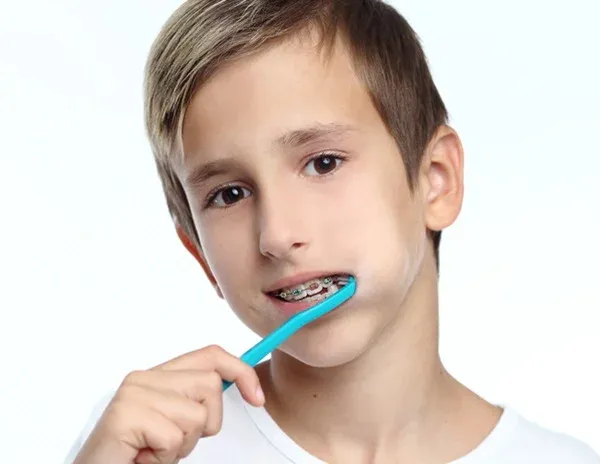Treatment Time: How Long Will You Wear Braces vs. Invisalign?
Dr. Hoss Abar
One of the most frequently asked questions about orthodontic treatments is how long the journey will last. Both braces and Invisalign are highly effective options for straightening teeth and improving overall dental health, but the time it takes to achieve results can vary significantly between the two. Understanding the typical treatment durations and factors that influence treatment speed can help you make a well-informed choice for your unique situation.
Braces vs. Invisalign: How Do They Work?
Before going to the treatment duration, it is important to know how each system works to give the result.
Traditional Braces
The most common type of braces are metal or ceramic ones that are bonded to the teeth; the brackets and wires place pressure on the teeth to gradually shift positions. The wires are tightened periodically to increase the pressure and facilitate the movement of the teeth. Braces are very flexible and can be used to correct almost any problem with the position of the teeth, whether it is a small or major problem that requires a complete change in the structure of the teeth.
Invisalign
Invisalign employs a series of clear, removable trays that are made from medical grade polymer. Every aligner is trimmed to fit the patient’s teeth and is supposed to move the teeth incrementally in the desired direction. New aligners are normally given to the patients every 1-2 weeks, and each set is designed to gradually adjust the teeth in the desired direction until the final result is achieved.
Average Treatment Duration
Traditional Braces: 18-36 Months
It takes an average of 18-36 months to wear traditional braces. The wide range is used to determine the extent of misalignment and the type of malocclusion being treated. When the problem is severe crowding, cross bites, or any other condition that may warrant jaw adjustments, treatment may take up to three years. For those with minor spacing problems, treatment might be needed at around 18 months of age.
Invisalign: 6-18 Months
Invisalign is faster than traditional braces; many cases are treated within 6-18 months. Cosmetic alignment issues that are mild to moderate can be corrected relatively fast. Nonetheless, in complicated cases or with patients who do not wear their aligners as recommended, treatment may take more than 18 months.
Factors Influencing Treatment Duration
While the average treatment times provide a general estimate, several factors can impact how long it will actually take to achieve the desired results. Let’s explore these variables for both braces and Invisalign.
1. Complexity of Misalignment
- Braces: Braces are a durable solution for complicated cases such as severe crowding, rotations and other malocclusions. Fixing these problems may take longer, but braces work well where there is a lot of shifting to be done. They afford more control to the orthodontists since they can make several adjustments through brackets as well as wires.

- Invisalign: Invisalign is most effective for those with minor to moderate spacing or alignment issues or minor bite changes. Some of these problems may require more time to correct through Invisalign, and some may not be treatable at all. If aligners are to be used in complex cases, other appliances, such as attachments or rubber bands, may be required, which may extend the time required for treatment.
2. Compliance and Consistency
- Braces: Another advantage of the braces is that they are fixed on the teeth and therefore there is no question of patient compliance. But, the patient should maintain proper oral hygiene so that the treatment time is not extended due to problems such as cavities or broken brackets.
- Invisalign: Invisalign treatment relies on the patient’s compliance to ensure the effectiveness of the treatment. They are worn for 20-22 hours a day to get the expected outcomes as with the braces. Patients who take out their aligners for a long time or don’t wear aligners at all may experience a delay, which can take months.
3. Age of the Patient
- Braces: Braces work for teenagers and adults, but children and teenagers may take a shorter time to have the braces removed because their jaws and teeth continue to grow. Adults can also get excellent results, but the treatment will require slightly more time because the bone is denser in this period.
- Invisalign: It is used by both teenagers and adults, but young people may have better outcomes than those with braces. Another issue of compliance is usually found in young patients because they are likely to remove their aligners. Features that are incorporated into Invisalign for teens can help monitor the amount of time that the aligners are worn.
4. Orthodontic Adjustments and Monitoring
- Braces: Orthodontists usually make appointments for adjustment of braces every 4-6 weeks to adjust or change the position of the wires. Such adjustments are necessary to keep up the progress, but in case of missed appointments, the timeline may be disrupted.
- Invisalign: Invisalign treatment appointments are usually recommended after every 6-8 weeks of the treatment. After some time, the orthodontist will assess your situation and give you the next sets of aligners. However, fewer changes are required, but it is crucial to attend the appointments to ensure the continuity of the treatment.
5. Patient-Specific Factors: Bone Density and Oral Health
- Bone Density: Bone density is one of the factors that may influence the braces and Invisalign treatments. Teeth are generally moved more slowly in adults because their bones are denser than those of teenagers. But for those who have lower bone density, the treatment may take lesser time.
- Oral Health: This is because healthy gums and teeth help progress faster. For those with gum disease or decay, they may be unable to receive either treatment until their condition stabilizes. Solving these problems is essential for the teeth shifting in the desired direction and at the same time for their safety.
Speeding Up Treatment Times: Options and Alternatives
There are a few orthodontic advancements and practices that can help speed up treatment times, regardless of the system used.
- Accelerated Orthodontics: Techniques such as micro-osteoperforation can cause bone remodeling and can possibly decrease treatment time.
- High-Frequency Vibration Devices: For 5-10 minutes a day, the devices vibrate lightly against the teeth and may reduce the time spent in aligner treatments as the bone surrounding the teeth can remodel faster.
- Good Oral Hygiene and Compliance: If proper care is taken, if aligners or braces are clean, and if all the instructions given by the orthodontist are followed, then there will not be any complications that may cause a delay.

Which is Faster?
In general, it is for this reason that Invisalign may take a shorter time to complete the treatment than traditional braces, especially for moderate cases. However, braces are more effective for complicated cases even though it will take time.
However, both braces and Invisalign are efficient and reliable orthodontic procedures that have their benefits in the sense of the time it takes to correct the misalignment and the type of misalignment that needs to be corrected. Both braces and Invisalign offer you the best of orthodontic treatment depending on your needs, but seeking the services of a professional orthodontist will help you get the right treatment plan for your needs. Ultimately, the selection of the proper system will guarantee that you get the desired outcome within the most appropriate time frame possible, given your circumstances.
Contact your Pinole dentist, Dr. Hoss Abar, DDS, MSD at Abar Orthodontics, to learn more about Braces vs. Invisalign.
Resource:
Orthodontic Preparation for Surgery
*This media/content or any other on this website does not prescribe, recommend, or prevent any treatment or procedure. Therefore, we highly suggest that you get the advice of a qualified dentist or other medical practitioners regarding your specific dental condition.*
More To Explore
About Us
We believe that every patient deserves to feel confident about their smile. Years of experience creating beautiful and flawless smiles.
Opening Hours:
Monday - Thursday: 8:00 AM - 5:00 PM
Friday: 8:00 AM - 12:00 PM
Saturday - Sunday: Closed
Abar Orthodontics, Pinole, CA
1500 Tara Hills Drive., Suite 204
Pinole, CA 94564
Abar Orthodontics, San Leandro, CA
145 East 14th street., #100
San Leandro, CA 94577
© 2025Abar Orthodontics | All rights reserved | Powered by:Vigorant, Inc.
